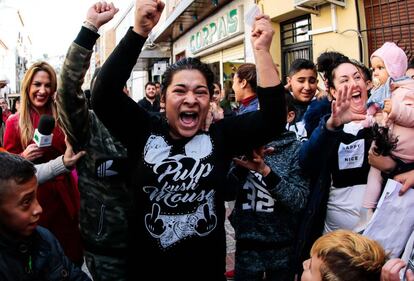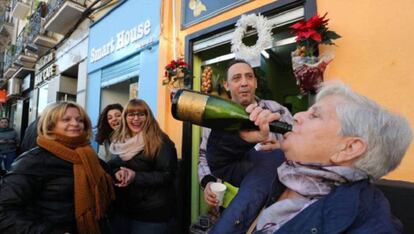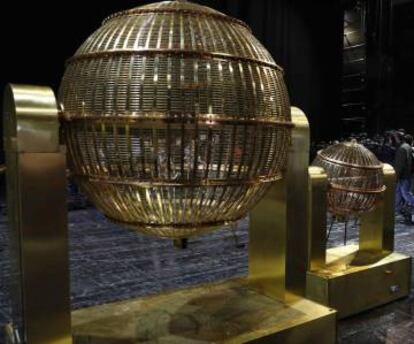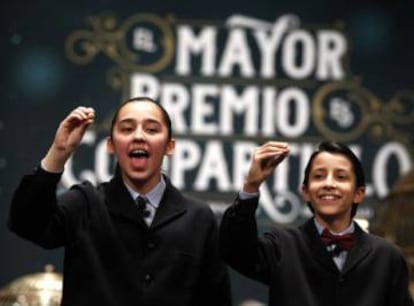A ‘guiri’s’ guide: What is El Gordo, and why is it so popular?
For those unfamiliar with the yearly tradition that is Spain’s Christmas lottery, here’s a quick explainer of the famous draw that has enchanted the nation for more than 200 years

Barring a major disaster, December 22 is the only day of the year when every TV news report, radio bulletin and online newspaper in Spain will be leading with images of people celebrating. Men and women hug one another, pop open bottles of champagne and dance in front of the cameras while showing off tickets with a five-figure number. They are the winners of Spain’s Christmas lottery, a tradition that is as enshrined in Christmas celebrations as turrón or the Three Kings. Last year, Spanish people spent €2.76 billion on lottery tickets – that’s €60 per person.
The lottery draw, which can last up to six hours, is followed live by millions of people on television, radio and online, and unofficially marks the beginning of the festive season. But seeing as there are dozens of lotteries and betting games that take place throughout the year and are booming online, why does this lottery – which began in 1811 – continue to be so popular?

The first thing that has to be said about Spain’s Christmas lottery is that it gives out a lot of money – 70% of overall ticket sales – but it doesn’t tend to turn anyone into a multimillionaire. Unlike other lotteries where the winner takes home an astronomical figure and can retire at once, those who hold a décimo (a fraction of a €200 ticket that costs €20) in the first-prize number – known as “El Gordo” (The Fat One) – win €320,000 after taxes. It’s a more than respectable prize: winners can free themselves of financial burdens, indulge in a whim they have always dreamed of, start a business or pay off student loans and mortgages. But typically, the top prize doesn’t set you up for life.

The prizes are not massive but there are lots of winners. And it’s common for them to know one another. Because numbers are also divided into 170 series, there are actually 1,700 décimos for every one of the 100,000 numbers. Work colleagues often buy a décimo with the same number. As do clients of the same company and members of neighborhood associations. So when a number wins, everyone wins. In other lotteries, a single winner, who almost nobody knows, is awarded millions. On December 22 however, the television cameras sent out to the lucky towns and neighborhoods that bought the winning number capture scenes of collective joy.
This element of community celebration is undoubtedly the reason why it is the most popular national lottery in Spain, especially of Christmas lotteries. It is also what encourages people to buy tickets. First to share in the fun of playing the same number as people close to you. But also so that you’re not left empty-handed if the number wins. In other lotteries, the only risk of not playing is not winning. With Spain’s Christmas lottery, there is the added risk that you will be left out of the party. That’s why lottery tickets are often shared: two or more people buy the same décimo or participación (a portion of the same ticket) so they win at least something if their number is drawn. It’s also a way of sharing the cost of playing.
Another very important part of the Christmas lottery is the event itself. It is most likely the longest and most ritualistic in the world. The numbers are drawn out by young boys and girls (but only since 1984, when the school became mixed) from the San Ildefonso school, which was founded in the 16th century and is the oldest in Madrid. Back then, it was an education center for orphans but now it is a public school with a notable number of migrant students.

The spectacle begins at 9am. That’s the moment two dome-shaped lottery machines begin to spin with numbered balls. One giant golden dome contains the 100,000 numbers that have been put up for sale, while the smaller one has 1,807 balls numbered with prizes. Of these, 13 are major prizes – from €6,000 for a décimo to €400,000 for El Gordo. The remaining 1,794 are prizes of €1,000 for every décimo or €5 for every euro (the so-called Pedrea). The children pull out the balls one by one, pairing numbers with prizes and singing out the figures in the fashion of Spain’s theatrical tonadilla songs. Another important point is that you never know the order in which the prizes will be drawn. This helps maintain the suspense during the hours-long event and draw in audiences across the internet, radio and television.
Once the lottery is over, the millions of Spaniards who have won nothing are congratulated because what’s important – and this is another part of the celebration – is good cheer. Almost everyone will play again the next year. Partly in the hope of winning hundreds of millions of euros with El Gordo. Partly not to look like a fool if their neighbor wins it.
English version by Melissa Kitson.
Tu suscripción se está usando en otro dispositivo
¿Quieres añadir otro usuario a tu suscripción?
Si continúas leyendo en este dispositivo, no se podrá leer en el otro.
FlechaTu suscripción se está usando en otro dispositivo y solo puedes acceder a EL PAÍS desde un dispositivo a la vez.
Si quieres compartir tu cuenta, cambia tu suscripción a la modalidad Premium, así podrás añadir otro usuario. Cada uno accederá con su propia cuenta de email, lo que os permitirá personalizar vuestra experiencia en EL PAÍS.
¿Tienes una suscripción de empresa? Accede aquí para contratar más cuentas.
En el caso de no saber quién está usando tu cuenta, te recomendamos cambiar tu contraseña aquí.
Si decides continuar compartiendo tu cuenta, este mensaje se mostrará en tu dispositivo y en el de la otra persona que está usando tu cuenta de forma indefinida, afectando a tu experiencia de lectura. Puedes consultar aquí los términos y condiciones de la suscripción digital.
More information
Archived In
Últimas noticias
How Japan is trying to avert ‘digital defeat’
From digital curfews to blocking apps: How technology experts protect their children online
Why the price of coffee has skyrocketed: from Brazilian plantations to specialty coffee houses
Confined to a Cuban hospital: When electricity is a matter of life or death
Most viewed
- Pablo Escobar’s hippos: A serious environmental problem, 40 years on
- Reinhard Genzel, Nobel laureate in physics: ‘One-minute videos will never give you the truth’
- Why we lost the habit of sleeping in two segments and how that changed our sense of time
- Charles Dubouloz, mountaineering star, retires at 36 with a farewell tour inspired by Walter Bonatti
- The Florida Keys tourist paradise is besieged by immigration agents: ‘We’ve never seen anything like this’











































